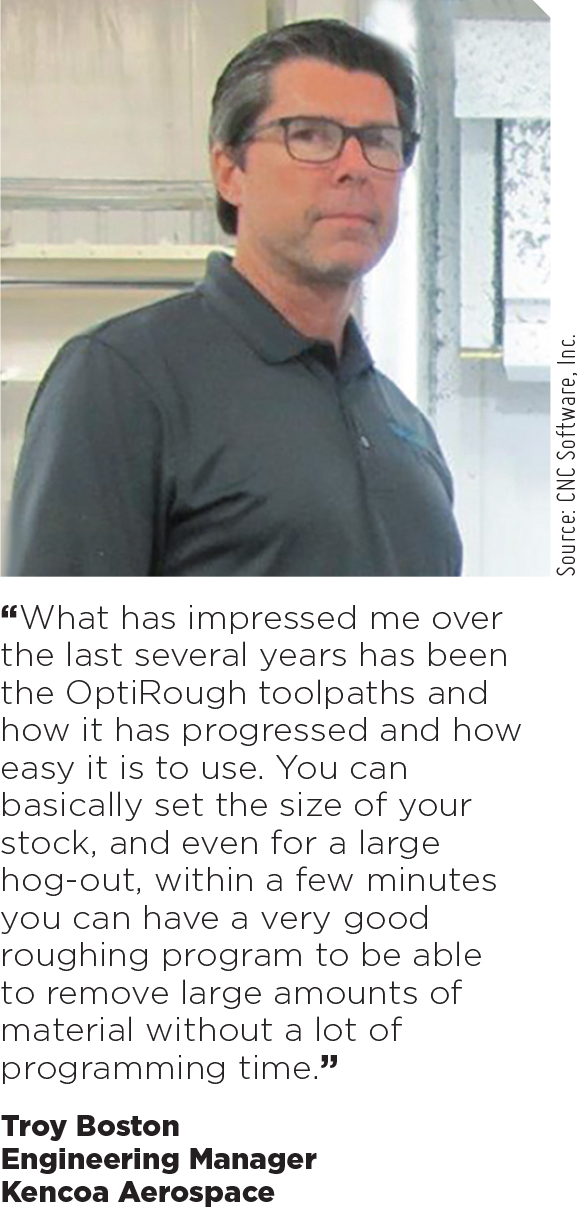The Sky's the Limit

Following is a compelling account of Kencoa Aerospace US-based operation’s turning to Mastercam® CAD/CAM software for its machining solutions. The software not only helps the company work on challenging orders, but does it with an unbelievable ease.
When 20 years ago Kencoa Aerospace began its operations, it was a small company focused on defense applications. According to Troy Boston, Engineering Manager, US-based Operations, Kencoa Aerospace, the company has now progressed
into commercial aerospace and produce diverse parts for well-known clients such as Boeing, Lockheed Martin, Gulf Stream, and more.
Headquartered in Korea, the US-based aerospace operation is a Tier-1 supplier of multi-axis precision machined aerostructures, jet engine components, and major assemblies of commercial, military, and business/regional jets.
“We machine anything from plastics, stainless steel, titanium, all the way up to Inconel,” he states. The part sizes the company creates can range from the size of a quarter up to 20-feet long. The majority of these parts are internal structural components for airplanes and can range anywhere from wing components to cargo floor skins.

OptiRough toolpaths for the track

Mastercam Roughing Track Screenshot
Mastercam software
To create the parts needed for these defense and commercial aerospace clients, Kencoa turned to Mastercam® CAD/CAM software (CNC Software, Inc., Tolland, CT) for its machining solutions.
The software allows Kencoa’s programmers to work on challenging orders including those with specifications that require holding close tolerances where their true position is 0.001 or a diameter that is +/– 0.0003” to 0.0010”.
“What has impressed me over the last several years has been the OptiRough toolpath and how it has progressed and how easy it is to use. You can basically set the size of your stock, and even for a large hog-out, within a few minutes you can have a very good roughing program to be able to remove large amounts of material without a lot of programming time,” shares Boston.
Now the company’s machines can run aluminum upwards of 400-in/min. Even with titanium, it is able to run its machines at over 100-in/min.
Faster production
Some particular parts, like those created for Spirit Aerosystems, are now much faster to make for Kencoa. “A model can come in from the customer through CATIA (Read/Write for Mastercam translator, MoldPlus SA) and it can be saved and opened into Mastercam. With one particular part, we were able to bring in the forging models and use that as stock, which cuts down on some of the roughing, how many roughing toolpaths are needed, or how much motion that it creates by having that stock model,” Boston explains.
For this, Kencoa used the OptiRough toolpaths, 2D Dynamic toolpaths, and then the traditional finish contour toolpaths. The majority of the material was removed with solid carbide end mills. “To do a rough and finish operation was around an hour and half total time, but years ago it would have been much more complicated and taken a much longer time to complete,” he notes.
Before using this software, the feed rates on the part would have been around 5- to 10-in/min, compared to the toolpaths that can now run up to 114-in/min.
This is only the tip of the iceberg in terms of how much time the software is saving Kencoa Aerospace. When forgings come in from a customer that requires Inconel parts, and the program needs to be modified because the forging is actually larger than anticipated, the company can modify the program and be up and running within a day and a half, or sometimes less.
Not all lead times can be this fast due to the complex nature of the parts required by the clients. Some aircraft parts have a four- to five-week lead time, while parts for NASA and the International Space Station can be an 18- to 24-week lead depending on processing. Another variable is that some of these parts must go through a stringent cleaning process and must be in air-tight, sealed containers when they leave the Kencoa shop.
 Working in solid models
Working in solid models
One more time-saving feature Kencoa enjoys is the ability to work directly in the solid models imported from CATIA. Sometimes a part might be missing geometry or even missing a face on the solid. It could even be that the radius blend is not clean, or the radius itself could even be missing just due to the way the solid comes in.
“Now, through Mastercam, we have the capabilities to fix that solid and that is a big advantage when it comes to machining. We don’t have to go in and recreate the solid, we can just fix the existing solid and start machining from there,” explains Boston.
Plentiful other options
Boston emphasizes that the company chose this software for its compatibility with all of the machines in the shop. Programmers rely on its Verify function, which allows them to see all fixtures, tool holders, and other parts on the machine. They can virtually run the program to ensure there will be no collisions or tool breakage during the machining process.
The software offers a lot of options and, as Boston says, it’s not just for machining at Kencoa. “We can use it for fixture design, assembly, and many different things.” With so many programming options for its 4- and 5-axis vertical machining centers, CNC turning centers, and 5-axis machining center, the sky’s the limit for this machining crew.
Sometimes a part might be missing geometry or even missing a face on the solid. With Mastercam’s CAD/CAM software, Kencoa now has has the capabilities to fix that solid, which is a big advantage when it comes to machining.



 Facebook
Facebook.png) Twitter
Twitter Linkedin
Linkedin Subscribe
Subscribe